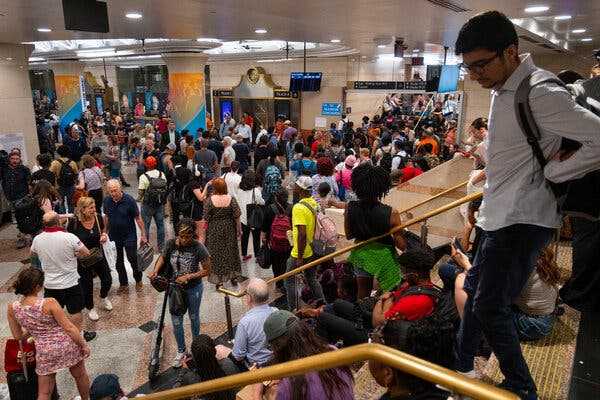The dated U.S. rail infrastructure is struggling to stay operational as climate change accelerates and intense heat waves, downpours and high winds become more frequent.
Listen to this article · 10:21 min Learn more
- Share full article

Total
100
minutes
All others and
unspecified
weather-realted
delays
90
Amtrak weather-
related delays
80
70
Cold
Snow/ice
60
Mud/rockslides
Rain/storms
Power failures
50
Trees
40
Wind
Floods
30
Wet/
slippery rails
20
10
High
temperature
’05
’10
’15
’20
’23

Total
100
minutes
90
Amtrak weather-
related delays
80
All others and
unspecified
weather delays
70
Cold
60
Rain/storms
50
Power failures
Mud/rockslides
40
Trees
Snow/ice
30
Wet/slippery
rails
Floods
Wind
20
High
temperatures
10
’05
’10
’15
’20
’23

Total
100
minutes
90
Amtrak weather-
related delays
80
All others and
unspecified
weather delays
70
Cold
60
Rain/storms
50
Power failures
Mud/rockslides
40
Trees
Snow/ice
30
Wet/slippery
rails
Wind
Floods
20
High
temperatures
10
’05
’10
’15
’20
’23

Total
100
minutes
90
Amtrak weather-
related delays
80
All others and
unspecified
weather delays
70
Cold
60
Rain/storms
50
Power failures
40
Trees
Mud/rockslides
Snow/ice
30
Wet/slippery
rails
Wind
Floods
20
High
temperatures
10
’05
’10
’15
’20
’23
The total minutes delayed in each weather category annually per 10,000 miles traveled by Amtrak trains nationally in each year.
Source: Amtrak
By Karl Russell

By Minho Kim
Reporting from Washington
July 17, 2024, 10:45 a.m. ET
On June 20, after millions of Americans had suffered through a sweltering heat wave for three days, Amtrak sent an ominous warning over social media: Trains connecting the largest cities in Northeast could face up to an hour of delay from high temperatures.
Later that afternoon, after the temperature peaked at 96 degrees in Newark, Amtrak lost electricity near the New Jersey side of the Hudson River tunnels. The power failure soon shuttered a 150-mile stretch of the busiest rail corridor in the United States for more than three hours. The impact reverberated until the next day, when trains chugged through with hours of residual delays.
As the planet rapidly warms, train delays and breakdowns are becoming more frequent as America’s antiquated rail infrastructure struggles to remain functional during prolonged extreme weather events that were not typical when the system was constructed.
A New York Times analysis of Amtrak data found that the rail service’s passengers have faced record delays in recent years caused by inclement weather such as heat waves, storms, floods, high winds, low temperatures, tornadoes, lightning and wildfires.
Extreme weather events bogged down Amtrak trains for more than 4,010 hours in the 2023 fiscal year, which began in October 2022 and ended in September 2023, according to a Times analysis of more than 313,000 individual train delay data dating to September 2003. That was the highest number of weather-related delays in at least 20 years.
Image

Passengers waiting at Penn Station in New York after a brush fire along the Northeast Corridor caused delays in June.Credit…Dakota Santiago for The New York Times
We are having trouble retrieving the article content.
Please enable JavaScript in your browser settings.
Thank you for your patience while we verify access. If you are in Reader mode please exit and log into your Times account, or subscribe for all of The Times.
Thank you for your patience while we verify access.
Already a subscriber? Log in.
Want all of The Times? Subscribe.
SKIP ADVERTISEMENT
Source: nytimes.com



